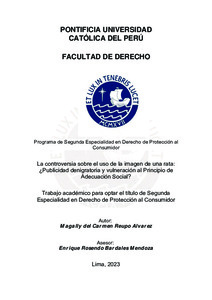| dc.contributor.advisor | Bardales Mendoza, Enrique Rosendo | |
| dc.contributor.author | Reupo Alvarez, Magally del Carmen | |
| dc.date.accessioned | 2024-04-01T14:06:06Z | |
| dc.date.available | 2024-04-01T14:06:06Z | |
| dc.date.created | 2023 | |
| dc.date.issued | 2024-04-01 | |
| dc.identifier.uri | http://hdl.handle.net/20.500.12404/27442 | |
| dc.description.abstract | Como sabemos, la publicidad comercial es utilizada como una herramienta
fundamental para que los proveedores de servicios o productos, se den a
conocer en el mercado y competir en él. Para lograr este objetivo, se hace uso
de la imaginación y creatividad para atraer a más personas para que contraten
realizando campañas que pueden tener un tinte cómico, reflexivo, dramático,
entre otras características.
Sin embargo, este uso de la creatividad para realizar las campañas publicitarias
tiene límites, en tanto no puede hacer referencia a la nacionalidad, creencias de
los titulares de la empresa o hacer uso “injustificado” de la sátira y sarcasmo,
entre otras razones presentes en la normativa correspondiente. Además, la
publicidad comercial tiene otro límite relacionado a que la publicidad no puede
incentivar acciones ilegales, discriminación por raza, sexo, religión, idioma o
publicitar servicios o productos eróticos a un público diferente al adulto.
El presente artículo busca analizar la controversia que recayó sobre la campaña
de la empresa de telecomunicaciones WIN, donde se utilizó la imagen recreativa
de un roedor. Las dos empresas denunciantes señalaron en su momento que,
por el uso de dicho animal y las frases que aludían a dicho animal, la campaña
era publicidad denigratoria y que además iba en contra del Principio de
Adecuación Social.
En ese sentido, aplicando lo que indica el Decreto Legislativo 1044, Ley de
Represión de la Competencia Desleal de manera conjunta con Resoluciones
emitidas por la Sala Especializada en Competencia Desleal del Indecopi como
también doctrina, se analizará si mediante la campaña publicitaria de WIN, se
realizaron actos de competencia desleal y se vulneró el Principio de Adecuación
Social. | es_ES |
| dc.description.abstract | As we know, commercial advertising is used as a fundamental tool for service or
product providers to make themselves known in the market and compete in it. To
achieve this objective, imagination and creativity are used to attract more people
to hire by carrying out campaigns that can have a comic, reflective, dramatic tone,
among other characteristics.
However, this use of creativity to carry out advertising campaigns has limits, as it
cannot refer to the nationality, beliefs of the owners of the company or make
“unjustified” use of satire and sarcasm, among other reasons present in the
corresponding regulations. Additionally, commercial advertising has another limit
related to the fact that advertising cannot encourage illegal actions, discrimination
based on race, sex, religion, language or advertise erotic services or products to
an audience other than adults.
This article seeks to analyze the controversy that fell on the campaign of WIN, a
telecommunications company, where a supposedly recreational image of a
derogatory rodent, like a “rat”, was used. The two complaining companies
indicated at the time that, due to the use of said animal and the phrases that
alluded to said animal, the campaign was denigrating advertising and that it also
went against the Principle of Social Adequacy.
In that sense, applying what is indicated in Legislative Decree 1044, Law for the
Repression of Unfair Competition, together with Resolutions issued by the
Specialized Chamber on Unfair Competition of Indecopi as well as doctrine, it will
be analyzed whether through the WIN advertising campaign, they carried out acts
of unfair competition and the Principle of Social Adequacy was violated. | es_ES |
| dc.description.uri | Trabajo académico | es_ES |
| dc.language.iso | spa | es_ES |
| dc.publisher | Pontificia Universidad Católica del Perú | es_ES |
| dc.rights | info:eu-repo/semantics/openAccess | es_ES |
| dc.rights.uri | http://creativecommons.org/licenses/by-nc-sa/2.5/pe/ | * |
| dc.subject | Protección del consumidor--Legislación--Perú | es_ES |
| dc.subject | Competencia económica desleal--Legislación--Perú | es_ES |
| dc.subject | Publicidad comercial--Legislación--Perú | es_ES |
| dc.title | La controversia sobre el uso de la imagen de una rata: ¿Publicidad denigratoria y vulneración al Principio de Adecuación Social? | es_ES |
| dc.type | info:eu-repo/semantics/bachelorThesis | es_ES |
| thesis.degree.name | Segunda Especialidad en Derecho de Protección al Consumidor | es_ES |
| thesis.degree.level | Título Profesional | es_ES |
| thesis.degree.grantor | Pontificia Universidad Católica del Perú. Facultad de Derecho | es_ES |
| thesis.degree.discipline | Derecho de Protección al Consumidor | es_ES |
| renati.advisor.dni | 08571041 | |
| renati.advisor.orcid | https://orcid.org/0000-0002-6986-6350 | es_ES |
| renati.author.dni | 72950939 | |
| renati.discipline | 421059 | es_ES |
| renati.level | https://purl.org/pe-repo/renati/level#tituloSegundaEspecialidad | es_ES |
| renati.type | https://purl.org/pe-repo/renati/type#trabajoAcademico | es_ES |
| dc.publisher.country | PE | es_ES |
| dc.subject.ocde | https://purl.org/pe-repo/ocde/ford#5.05.01 | es_ES |







